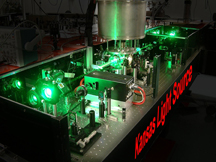Lighting the way
Physics lab is on the cutting edge of ultrafast laser research
For decades, the J.R. Macdonald Laboratory at K-State has been known worldwide as a center for atomic collision physics using particle accelerators. Now, researchers at the lab are working toward making it known for ultrafast laser science.
 The Macdonald Lab is the main part of the K-State atomic, molecular and optical physics program, which has ranked in the top 20 in the nation out of all such university programs, according to U.S. News and World Report. In recent years the lab has shifted its research focus to ultrafast laser science. This change in emphasis was marked with the installation of the Kansas Light Source, an intense ultrafast laser, a few years ago.
The Macdonald Lab is the main part of the K-State atomic, molecular and optical physics program, which has ranked in the top 20 in the nation out of all such university programs, according to U.S. News and World Report. In recent years the lab has shifted its research focus to ultrafast laser science. This change in emphasis was marked with the installation of the Kansas Light Source, an intense ultrafast laser, a few years ago.
"There are advantages to both ultrafast laser research and accelerator research," said Itzik Ben-Itzhak, Macdonald Lab director and K-State professor of physics. "The laser gives you the ability to control a reaction occurring within a molecule and not just to observe that phenomenon. Just imagine what opportunities such control could lead to in molecular engineering."
The basic physics research at the Macdonald Lab could one day enable researchers to tailor molecules to improve health care, energy and security. Ben-Itzhak said that the Macdonald Lab's work to investigate these fundamental processes and find out the optimal laser characteristics -- such as intensity, pulse duration and spectrum -- is the first step down a long road.
"We're not trying to be solely a laser technology lab," Ben-Itzhak said. "Rather, we are interested in studying laser-matter interactions on the atomic and molecular scale. However, in order to be in the forefront of this rapidly evolving field, we have to have the right balance between developing our laser technology, i.e. instrumental capabilities, and immediately interrogating matter with them."
The Macdonald Lab houses nine K-State faculty experts and brings in $2.5 million from the U.S. Department of Energy annually.
Department of physics faculty include: Zenghu Chang, professor; Lew Cocke, distinguished professor; Brett DePaola, professor; Brett Esry, professor; Vinod Kumarappan, assistant professor; Chii-Dong Lin, distinguished professor; Igor Litvinyuk, assistant professor; and Uwe Thumm, professor. Research faculty include: Kevin Carnes, associate research professor; Charles Fehrenbach, research assistant professor; and An Thu Le, research assistant professor. Also included are atomic, molecular and optical physics program faculty Kristan Corwin, associate professor, and Brian Washburn, assistant professor.
These researchers leverage the DOE funding and the infrastructure it provides to bring in additional funding from the National Science Foundation, the Army Research Office and the Air Force Office of Scientific Research, among other sources. All together, the atomic, molecular and optical physics group brings in more than $4.7 million per year in grants.
In addition to the Macdonald Lab members, the Kansas Light Source also is used by others at K-State. For example, Shuting Lei, associate professor of industrial and manufacturing systems engineering, and his group uses the lasers to drill holes because they are much cooler, temperature-wise, than using a drill press.
Ben-Itzhak said the lab's switch to ultrafast laser science has generated an increased demand for laser time. That's why the lab is working to acquire another laser that can provide new research opportunities and relieve the logjam on laser time.
Photo: K-State's J.R. Macdonald Laboratory is becoming so well known for ultrafast laser science, that the demand for laser time has outstripped its resources. Officials are in the process of acquiring a new laser to boost the lab's research capabilities. Photo courtesy of the J.R. Macdonald Laboratory.